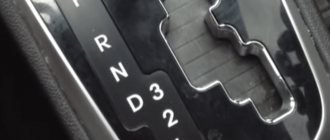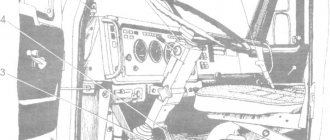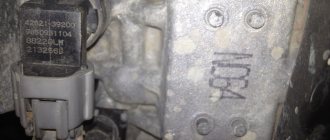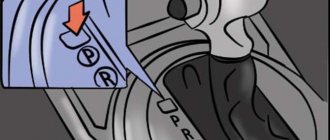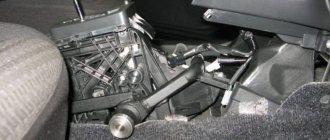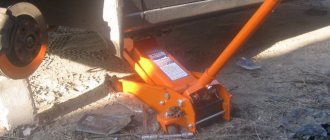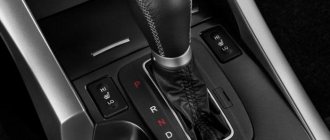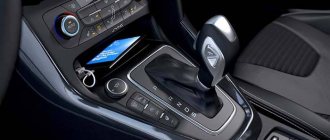What to do, how to behave
Actually, there are no complex algorithms, but there are a few things to remember:
- If you notice that “R” is on, do not accelerate
- Don’t switch to “D” right away, it’s fraught!
- You need to stop and after a complete stop, switch to “DRIVE”
Why do you need to do it this way, and not immediately transfer from “R” to “D”? WE have already realized that in modern cars, when such an error occurs, neutral is switched on, in which you can roll, but you should not turn on DRIVE from it
It's all about the torque converter (now there will be exaggerated information to simply understand the principle), it has two impellers: the first is connected to the engine, the second to the transmission.
When you move forward, then oil pressure is transmitted from one to the other, that is, torque
. And at speed they rotate the same. As soon as you turn on “N” (or in our case “R”), the machine disengages the connection, the impellers begin to rotate at different speeds. If you apply pressure sharply (that is, turn on “D”), it can damage parts of these turbines, so you must first level it (stop), then move off (I think I explained it clearly).
Was the information useful?
Engaging reverse gear at speed: risks and possible consequences
So, on manual transmissions, the gear shift scheme is implemented quite simply, and the inclusion of reverse gear on most modern cars has additional “protection”, which requires the need to lift a separate lock.
On cars with automatic transmission, the selector moves in different modes, and the lever cannot be moved without pressing the brake pedal. While driving, switching automatic transmission modes also requires pressing a separate button on the lever.
However, some drivers, for one reason or another, still manage to accidentally engage reverse gear R in both manual and automatic transmissions, after which many concerns arise regarding the possible consequences. Let's figure it out.
First of all, there is a lot of different information circulating among car enthusiasts regarding engaging reverse gear at speed. Some argue that if you engage the rear while driving forward, serious wear or breakdown of the manual transmission is inevitable. In the case of an automatic transmission, such a box may even fail.
At the same time, other car enthusiasts do not share the panicky mood, as they firmly believe that everything is provided for in modern boxes and nothing bad will happen. Let's see who is right.
- First of all, the manual transmission mechanics will not allow you to simply engage reverse gear while driving. If you try to do this, you may hear a strong cracking sound, crunching, etc. However, this sound does not mean in any way that a critical failure immediately occurred in the box.
In a nutshell, the gearshift lever on a manual transmission has a rigid connection with the gear shift fork(s). Also, when driving forward, the gearbox shafts (primary, secondary, intermediate) rotate in one direction. After engaging reverse gear, the shafts should rotate in the other direction.
On a completely immobilized car, reverse gear is easily engaged, however, taking into account the design features, when moving forward, it is extremely difficult to “stick” the reverse gear, although it is possible.
Also, the reverse gear on most cars does not have a synchronizer (it is not necessary), since this gear is only engaged when the car is completely stopped. If the car is moving, the gear will often not engage, but instead there will be a strong crunching sound.
If we consider the issue in more detail, in a manual transmission, when changing gears, the rotation speed of the coupling, which is equal to the rotation speed of the driven shaft, is synchronized with the rotation speed of the gear.
Synchronization is possible thanks to the presence of a synchronizer. Considering that the reverse gear rotates in the direction opposite to the rotation of the gears and the rotation of the clutch, it becomes clear that the clutch splines simply cannot engage with the reverse gear.
This is what prevents you from engaging reverse gear when moving forward. There will be a crunch, but the clutch will not engage, that is, the gear will not engage. If you try to engage the rear wheel several times while driving, you can damage the synchronizer, clutch or gear.
- Now let's move on to the automatic transmission. Let us immediately note that in this case, engaging reverse gear will not mean that a critical breakdown has occurred. First of all, there are several types of machines that are controlled mechanically and electronically.
Old automatic transmissions have cable control. To protect the box, a lock is activated, and a prerequisite for removing it when reverse gear is engaged (mode “R”) is to press the brake pedal. In other words, you won’t be able to engage the rear without pressing the brake.
Modern automatic transmissions are controlled electronically, that is, the automatic transmission lever (selector) does not have a rigid connection with the gearbox itself. In other words, its movement is simply an electrical signal that is sent to the actuators.
It turns out that even if the driver engages the rear automatic transmission at speed, the electronic unit, which receives information from a group of sensors (speed sensor, TPS, etc.), will consider such inclusion a failure or error.
Simply put, the box will switch to neutral “N”, and the “R” switch may light up on the panel. It turns out that the reverse gear simply will not engage, the car will roll in neutral. The only thing is, if this happens, in this case you need to proceed correctly.
- If the driver notices that the automatic transmission is in “R” mode, there is no need to press the gas pedal. Also, do not rush to switch the selector to “D” mode, which can also lead to failures and errors.
First of all, stop the car completely, then switch to “N” and take a short pause, and only then you can switch to “Drive” and continue driving. The need for such actions is dictated by the presence of a torque converter in the automatic transmission device.
We also recommend reading the article about
how to operate automatic transmission correctly
. From this article you will learn about the features of using an automatic transmission, as well as what to pay attention to when operating a unit of this type.
If, immediately after accidentally turning on reverse gear, you try to switch back to drive while moving, as mentioned above, in fact, a car rolling in neutral will be transferred to mode “D”.
So, a torque converter is a device with two impellers, between which torque from the engine is transmitted through oil. Under load, their rotation speeds are approximately equal.
If the car just rolls (turn on “N” at speed or by mistake “R”, which will also lead to neutral being turned on), the connection between the transmission and the motor is interrupted, the impellers begin to rotate at different speeds.
If you abruptly connect “D”, the oil pressure will increase, which may cause damage to the impeller in the gas turbine engine. It is for this reason that you must first stop the car, then switch from “neutral” to “drive” and only then move off.
Finally, we note that in the case of CVTs and robotic gearboxes, it will also not be possible to turn on the reverse gear while moving, since turning it on will not allow the electronics and a number of existing locks.
How to shift gears on an automatic transmission
So, in our previous article we looked at how to engage reverse gear on a manual transmission, as well as how to correctly shift gears on a manual transmission. Now let's look at the automatic transmission.
First of all, there are several types of automatic transmissions: “classic” hydromechanical automatic transmission, CVT, and also robotic gearbox. It should be noted that although these types of “automatic machines” differ from each other structurally, they are functionally similar and have similar basic operating modes.
Among these main modes are:
- R- parking, parking;
- R - reverse gear;
- N-neutral;
- D - drive, forward movement;
- M - manual control mode;
Park mode allows you to start the engine, after which the engine idles (for example, during warm-up). It is also recommended to leave the car parked in this mode.
It is noteworthy that after turning on “P” the automatic transmission shaft locking is also activated. This blocking prevents the car from rolling and is an additional “insurance”.
Mode “R” is responsible for reverse gear and is activated only after the car has come to a complete stop. Ignoring this rule may cause serious damage to the gearbox.
The “N” mode, unlike the “P” mode, allows you to separate the transmission and the engine, and this mode does not have any additional locks (as in the case of “parking”).
However, unlike “mechanics” and some individual types of robotic gearboxes (for example, AMT), during a short stop with the internal combustion engine running, there is no need to switch to neutral. In fact, “neutral” on an automatic transmission is only needed for towing the car in the event of a breakdown (if the manufacturer has provided for such a possibility), and also as a service mode.
Article on the topic: The principle of operation of the gearbox synchronizer and malfunctions
You can also turn on the “N” mode in a traffic jam, when the car has been standing for a long time (more than 10 minutes) and the engine is running, but you need to remember that in this case you need to additionally use the handbrake (parking brake) or hold the car with the brake pedal, otherwise the car may start rolling randomly.
Mode “D” allows you to move forward, gears change automatically. No additional action is required from the driver; all that remains is to press the gas to accelerate and the brake to slow down or come to a complete stop.
You can also highlight M - manual control mode (Tiptronic automatic transmission). The mode is not available on all automatic machines; if it is available, there are additional symbols: “+” (switching to an upshift), “-” (switching to a downshift). This mode is semi-automatic (the driver himself selects one gear or another, but the electronics may still not turn it on if the speed and conditions do not correspond to it).
- The gear shift lever itself (automatic transmission selector) on different cars with an automatic transmission, regardless of the type, often simply moves along special grooves. Each slot corresponds to a separate mode (as a rule, there are symbols next to the slot; also, the selected modes on most cars are duplicated on the dashboard).
To turn on one or another automatic transmission mode, you need to insert the key into the ignition and press the brake pedal. Typically, pressing the brake pedal releases the lock, which is a “protection” against accidental movement of the selector.
In parallel, on the side of the selector handle on many types of automatic transmissions there is a special button, pressing which allows you to move the lever to one mode or another. In other words, pressing the brake pedal and holding the pedal allows you to unlock the shaft in the “parking” mode, while pressing the button on the lever makes it possible to further move the selector itself, including the desired modes.
Also, on many cars, starting the engine is only allowed in “P” or “N” mode when the brake is pressed. This solution can be considered a “protective” function that helps prevent unwanted vehicle movement and damage to the automatic transmission and internal combustion engine.
Article on the topic: How to stop a car if the brakes fail at full speed
Let us also add that many automatic transmissions, in addition to the main ones, are equipped with a number of other additional modes. Such modes can have either separate slots for activation or can be activated using buttons. For example, you can select only the first gear (mode L1 or 1), inclusion in automatic mode no higher than the second gear (L2 or 2), OD (overdrive) mode, which disables the transition to upshifting fourth or fifth gear.
Also, automatic transmissions often have a “sport” mode (letter “S”), an economical “eco” mode (letter “E”), winter mode (letter “W” or a snowflake icon), etc.
Why is reverse gear difficult to engage?
Regardless of what type of transmission is installed on the car (automatic or manual), poor engagement can be encountered at any gearbox. In such a situation, it is necessary to identify the breakdown and make repairs, since it is impossible to drive a car without reverse gear. Let's look at each reason in more detail.
Wear of the rocker bushing
Sometimes turning on reverse gear is accompanied by a lot of vibration and a characteristic crunch. The gear knob moves hard. In this case, the adjustment of the link, which connects the rod and the gear shift lever, may be disrupted. In addition, plastic bushings wear out quickly and must be replaced on time.
An experienced driver may notice excessive looseness and play in the lever. But if the wear occurs gradually, then it is difficult to notice the increasing free play. All repair work can be done directly from the salon. It is enough to remove the gear knob cover, remove the rocker and replace the bushing. After adjustment, the inclusions become clearer and softer.
The durability of a plastic part depends on the quality of the material used by the manufacturer. After adjusting the stroke of the rocker and replacing the bushing, this problem disappears. Sometimes craftsmen replace the factory mechanism with a shortened stroke. But they often forget that for it to work properly, it needs to be more accurately configured.
Electronics faults
Vehicles are equipped with different gearbox locking devices. Some vehicles use electromagnetic locking. In this case, the electrical wiring is located under the bottom of the car and is not protected by anything. In off-road conditions, the wires must be protected from damage, otherwise they will quickly become unusable. As a result, the supply of electricity to the interlock will stop and a problem will occur related to gear shifting.
Transmission traction is broken
Some cars are equipped with transmissions in which the shift rods are located outside the mechanism housing. In difficult climatic conditions (dirt, snow, icing), the free movement of traction is disrupted. This is especially noticeable when switching reverse gear, since it is rarely used. But in the morning it is necessary to leave the garage. To avoid such problems, in difficult conditions it is recommended to use a car that does not have external gear shift rods.
Note! Sometimes the length of the rod changes due to the loosening of the adjusting nuts, making shifting difficult. In this case, you will need to adjust and adjust the length, and the issue will be resolved.
There is not enough oil in the gearbox or its properties are reduced
If you do not take care of your car, a problem with engaging reverse gear may occur due to insufficient oil in the box or a deterioration in its performance properties. Inexperienced drivers believe that oil is poured into the gearbox all the time, and there is no need to change it. In reality, even high-quality lubricant with high mileage (about 100 thousand km) becomes unsuitable for use. These data correspond to a gentle driving mode.
But if the car is operated in difficult conditions associated with temperature changes, city traffic, and frequent switching, then the oil needs to be changed much more often. Over time, the properties of the lubricant change. Additives no longer work properly, harmful deposits, wear products, and dirt appear.
With dirty old oil, the gearbox mechanism works with difficulty not only when engaging reverse gear, but also other gears. It is necessary to pay attention to the presence of leaks under the car. If the lubricant leaks and its level is reduced, then the gearbox parts will wear out much faster than the period set by the factory.
Wear of release bearing, springs, gears, forks
Failure of the listed parts is accompanied by extraneous knocking or noise while driving, which is easy to hear. Reverse and other gears will be difficult to engage, or will become inaccessible altogether. To eliminate such malfunctions, you will need the help of specialists from a car repair shop. In this case, the gearbox will have to be removed from the car, so you should not start repairing this important unit yourself. This way you will save money and prevent further breakdowns.
Usually the fault is detected on the road: you stop at a traffic light, and when you try to shift into gear, difficulties arise. Cracks often appear on the shift fork, which even under light loads lead to the destruction of the entire part.
It happens that when starting off on loose snow or sand, the reverse gear switches off spontaneously. The handle has to be held forcibly.
The reasons may be the following:
- Displacement of the motor on the cushions and knocking out the speed.
- Worn synchronizer clutch or gear.
- The fastening of the link is loose and does not hold the fork in the desired position.
Note! The driver can independently tighten the engine mounts and secure the rocker. To do this, the car will need to be installed on a pit or overpass.
Incomplete clutch disengagement
The gearbox and motor are connected by the clutch mechanism. When changing speed, the driver presses a special pedal to disconnect the gearbox from the engine. Then the desired gear is engaged and the clutch pedal is released. After this, torque is again transmitted to the wheels.
What to do if reverse gear does not engage
1. If noises and grinding noises are heard: turn off the engine and stop trying to turn it on - the gearbox or clutch has failed. The solution is to contact a specialist, or push the car out and drive to the nearest workshop, without engaging reverse gear. 2. If there are no extraneous sounds when you turn it on, but you can’t turn it on, try again, taking into account the characteristics of your car: perhaps you do not recess the lever, or do not move it to the side enough. And lastly: any actions to turn on the speed must be carried out with the clutch pedal depressed.
Difficulty engaging first and reverse gears
These two speeds cause problems for drivers on most car models. The reverse gear does not engage well due to the fact that there is no synchronizer on its gear. They are installed only on higher-class cars, and they are not on budget cars. The first speed also often makes it difficult to drive a car, since it is used more often than others. Although a synchronizer is always installed on its gear.
More of these faults can be found on used cars. But even on new budget class models such breakdowns are not uncommon.
Wear of release bearing, springs, forks, gears, synchronizers, shafts
As a rule, all these breakdowns are accompanied by extraneous noise during operation, which is difficult to ignore. Repairs will require dismantling the gearbox and the participation of specialists. Your task is not to delay your visit to the service station. This will save you money and possibly prevent irreversible damage.
We deliberately did not touch upon the problems with engaging reverse gear in an automatic transmission, for the simple reason that automatic transmissions are foolproof from birth - it is very difficult to break them yourself. But the most important thing is that the automatic transmission signals the driver about its problems with characteristic jolts when operating in normal mode. It is impossible not to notice them.
Text belongs to:
Reverse gear malfunctions in manual and automatic transmissions
Depending on the design, gear shifting in modern manual transmissions can be direct or rocker.
Direct switching
Direct shift gearboxes operate on the following principle:
- When the lever moves, force is transmitted to the box.
- The ball joint acts on the fork to change gear.
- To prevent the inclusion of other speeds, limiters are used.
It is with the limiters that problems most often arise, leading to the fact that the reverse speed stops engaging. To assess the degree of wear of these parts, you need to completely disassemble the unit. Typically, if the limiters are in very poor condition, the fork and supports will need to be replaced along with them.
Rocker switch
In this case, to change the gear ratio, rockers located between the lever and the box are used (some manufacturers use cables instead of rockers). In most cases, two scenes are used: one provides the ability to select a gear, and the second is responsible for shifting.
As a rule, in such boxes the lever responsible for engaging the reverse gear is a bolt. During operation, this element is subject to vibration loads, as a result of which it can become unscrewed. As a result, problems arise with engaging reverse gear. Fixing the problem is quite simple: just return the bolt to its proper place.
Note that in the rocker boxes installed on VAZ cars of the 10th model, there is often a problem with engaging not only reverse gears, but also other gears. In most cases, this is due to stretching of the link. Diagnostics is very simple: just measure the length of this part. If it has increased, then you need to replace it with a new one and the problem will be solved.
Other Causes of Reverse Speed Problems
It happens that the reverse gear does not work due to mechanical wear of parts. To carry out diagnostics, there is no need to disassemble the box. It is enough to do the following:
- Check the transmission oil level and add it if necessary.
- Pay attention to the presence of extraneous noise when moving backwards (may indicate wear of the synchronizer or gears).
- A clear sign of wear is a gear that jumps out (in this case, you will have to disassemble the box).
It is important to understand that all parts of the manual transmission work in close interconnection. Therefore, if there are malfunctions, it is better not to limit yourself to local work, but to carry out a major overhaul and forget about problems with the transmission for a long time.
Automatic transmission: reasons for reverse gear not working
A transmission malfunction can be determined by the Check engine indicator located on the panel, but this button does not always light up. Possible problems:
- Errors in the operation of the electronic control unit.
- Malfunction of solenoids.
- Destruction of sealing rings.
- Breakage of clutches.
The cause can only be identified by disassembling and carefully inspecting the unit. In addition, diagnostics require specialized equipment, so it is almost impossible to perform this work in a garage environment.
Don't delay repairs!
Reverse gear is the most vulnerable part of manual and automatic transmissions. Of course, if it fails, you can still operate the car for some time without any problems. However, after some time, related breakdowns will occur. As a result, you will have to completely change the transmission. Therefore, it is better to immediately contact a car service, and not wait until the last minute.
Land Rover Discovery
It is equipped with automatic transmission series ZF, TF, JF. The main problem with a Discovery automatic transmission can be natural wear and tear of the housing or damage to it. Automatic transmission repair on Discovery is not cheap; a transmission from a German manufacturer usually lasts 80,000–100,000 km. The automatic transmission on Discovery is adaptive and adapts to the driving style of the car owner. If the driver drives the Discovery in an aggressive manner, the transmission does not have time to work out and goes into error. In order to diagnose the automatic transmission in Discovery, you must first reset the errors; perhaps the reason is in the driver, and not in the mechanical part. The oil on Discovery needs to be changed every 48,000 km. Automatic transmissions on Discovery are installed of a new generation, 6-speed, the electronic unit is located on top of the box, which reduces its dimensions. However, this arrangement can cause the electronic unit to overheat on Discovery and, ultimately, simply burn out. Also, the solenoid valves on Discovery are not the most reliable.
Land Rover Discovery with automatic transmission
Box nuances
The VAZ 2114 uses a five-speed manual gearbox. It is quite simple in design, which allows you to independently carry out preventive and repair work.
Device diagram
Experts recommend identifying a malfunction at the initial stage of its occurrence, since delaying means wasting even more time, effort and money.
Fifth gear
Rice. 38. Fifth gear
Modern cars are equipped with five-speed gearboxes. Fifth gear is often called "overdrive". When driving at high speed, it allows the engine to operate in a gentle mode and the driver to save fuel.
We’ll talk about gear shifting tactics a little later, but for now we need to learn how to turn fifth gear on and off (Fig. 38).
The fifth gear corridor extends beyond the previous diagram. Therefore, to enable it, you must follow a certain sequence:
- We push the ball out of the “hole” of fourth gear, and the spring immediately puts it in the neutral position (Fig. 38, item 0);
- Overcoming the counter force of the spring, we move the ball to the neutral position, located in the third corridor, and lightly rest against the wall (Fig. 38, position 0″). In this case, the spring seems to turn in the other direction and will try to return the ball to the main corridor;
- Next is the already known action. First we move along the corridor to the “hole”, then we drop the ball into it, and we have fifth gear.
The fifth gear is turned off in the same way as all the others - with one short movement of the hand, only helping the ball get out of the “hole”. Then the spring itself puts it in a neutral position between third and fourth gear in the main corridor.
Theory of gearbox operation
At the moment, all modern gearboxes are equipped with synchronizers, which are important elements of the gearbox. The essence of how synchronizers work is that they equalize the operation of the gearbox shafts.
Every driver, when switching from second to first gear, has encountered a situation where some kind of obstacle was felt. What prevents you from engaging first gear while driving. This is the synchronizer.
If you have a fairly new transmission, then when switching from an upshift to a downshift you will not find yourself in such a situation. Switching will be carried out without problems. This manifests itself as the components of the unit are used and worn out.
Watch a video about the design and operating principle of the gearbox:
Transmission
Purpose and features of the gearbox device. The principle of operation of gearboxes. Specifics and advantages of different types.
The gearbox or gearbox (Gearbox) is one of the most important transmission units - along with the driveshaft, clutch and rear drive axle. As a component of the transmission, the gearbox is typical for all internal combustion engines.
Rocker bushing, if the rocker bushing is worn out, how to fix it
A certain looseness of the lever may indicate wear of the rocker bushing. Although, if its wear proceeds evenly, that is, it runs its course, the driver may get used to the free movement of the rocker, as a result of which he will not notice impending problems. The situation is solved by replacing the bushing - remove the lever cover, and then dismantle the rocker itself. Then we replace the plastic bushing with a previously purchased one and install everything in place. This event takes place inside the car.
Functionality check
Before blaming the sensor for the malfunction of the reverse signals, make sure that the device has actually lost its functionality. To do this, run the diagnostics:
- Turn the wheels to the left all the way and look at the sensor from the driver’s side - there is a protection on the side of the gearbox, and contacts inside it;
- Remove this protection and inspect the device. There are also two contacts going to the sensor;
- Close the contacts on the frog limit switches (this is the same reverse sensor) and start the engine, engaging reverse gear;
- If everything is fine, the wires and contacts are working properly, then the white headlights will turn on;
- If the headlights do not light, use a tester to check the voltage on the wire (orange) and ground;
- If there is voltage, check the light bulb board and the quality of the contacts.
Causes of the problem and solutions
There are several most common reasons why the DZH fails. But there are countermeasures that can return the sensor to operation.
| Causes of the problem | Actions |
| The contacts on the wiring have oxidized | They just need to be thoroughly cleaned and returned. In this case, the negative terminal of the battery must be disconnected |
| The sensor is loose | As the sensor is used, it may move out of its seat. Screw it in tighter |
| There is no contact with the wiring in the gearbox | Check the condition of contacts and wires. Clean or replace damaged parts |
| There is no contact between the plug and the fuse box | Also check the condition of the contacts, clean them, change the wiring |
| Fuse blown | Here the situation can only be corrected by replacing the fuse |
In some situations, the sensor is working properly, the contacts are intact and the wiring is undamaged. In this case, the light bulbs themselves burned out. They are easy enough to replace.
